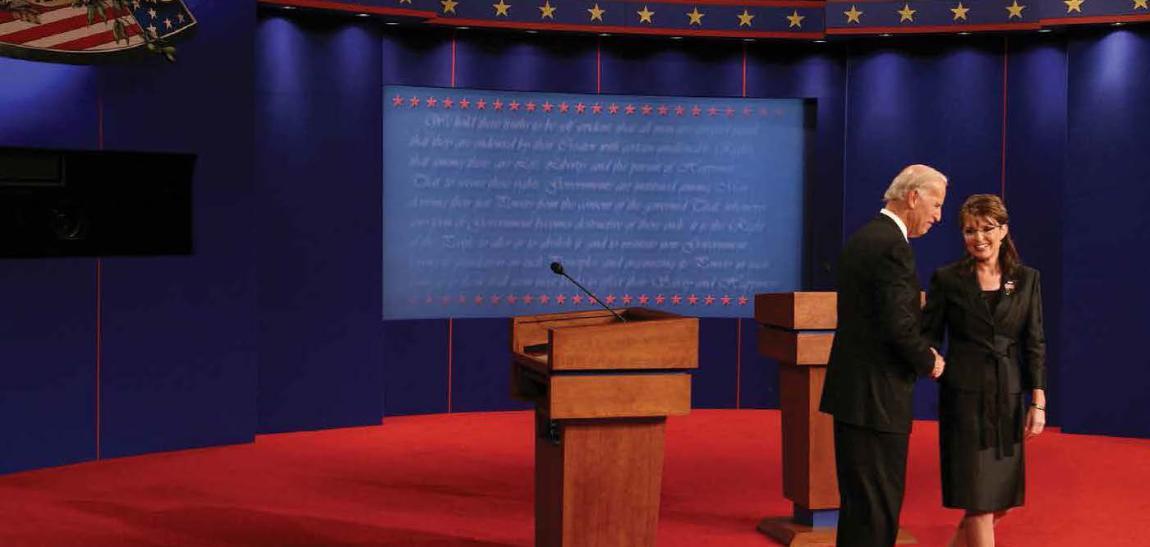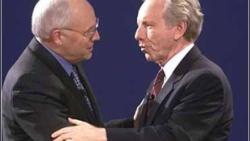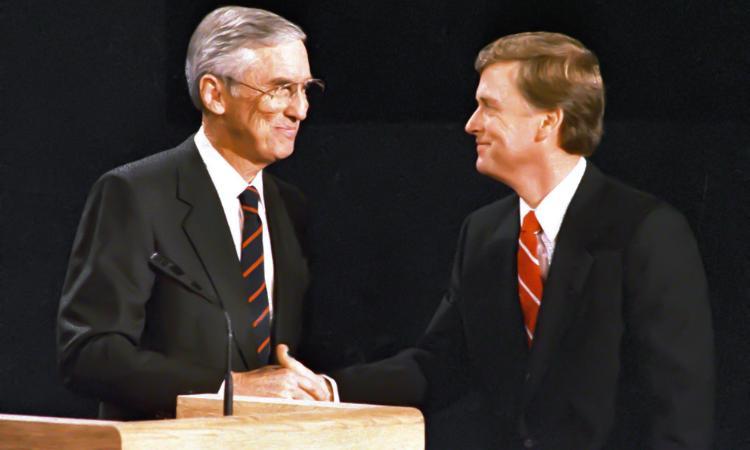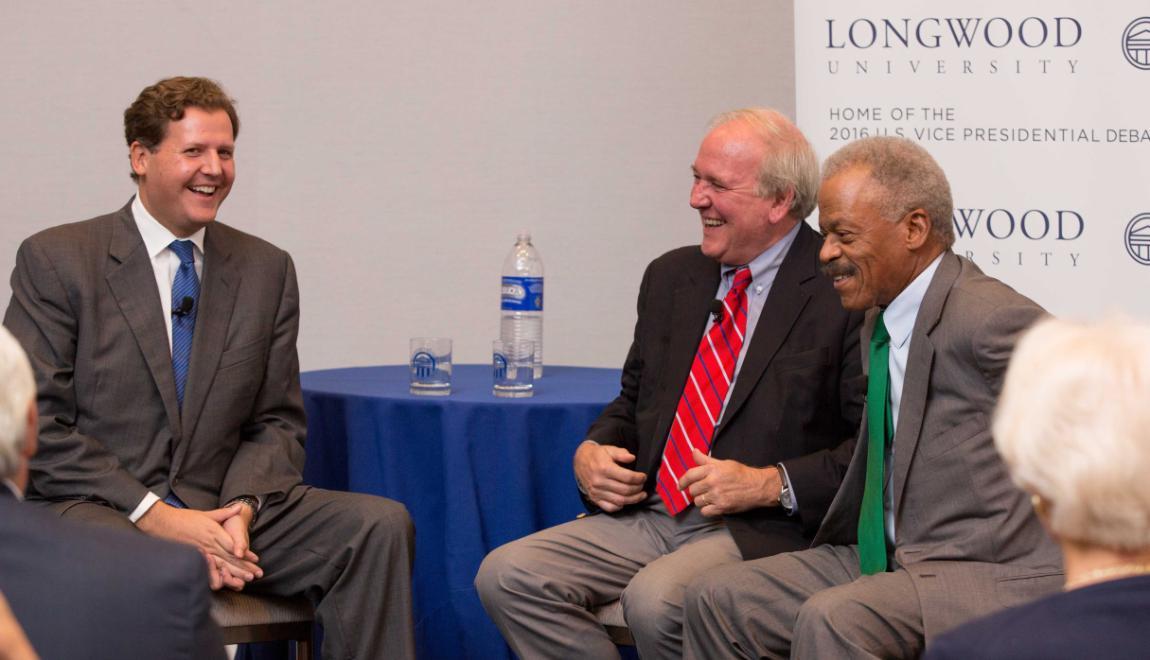

It’s no surprise that thousands of journalists are in Farmville for the 2016 Vice Presidential Debate tonight between Gov. Mike Pence of Indiana and Sen. Tim Kaine of Virginia.
When the vice presidential candidates meet on stage for their lone debate each election cycle, the undercard often garners as much attention as the title match.
This year marks the 40th anniversary of the Vice Presidential Debates—and it’s probably no coincidence that the same period has seen a dramatic rise in the influence and power of the office of the vice president.
Tuesday night’s debate is one many political experts predict will be a substantive high point of the 2016 general election. In fact, that’s often been the pattern with past Vice Presidential Debates, which historically have often proved more enlightening and memorable than the Presidential Debates—and in some years nearly as widely watched.
Here’s a look back at some important moments in Vice Presidential Debate history.
“It’s all about one night – that’s the only chance they have. It’s really their introduction to the national audience.”
Joel Goldstein, professor at St. Louis University and an expert on the vice presidency
A Model of Civility

The 2000 Vice Presidential Debate between Democratic Sen. Joe Lieberman and Dick Cheney is considered by many pundits to be the most civil, substantive conversation in the modern history of the debates, presidential or vice presidential.
The moderator was Bernard Shaw of CNN, who joined Commission on Presidential Debates co-chair and former White House Press Secretary Mike McCurry on stage last week at a Debate Countdown Reception hosted by Longwood in Washington, D.C.
What drove the civility and substance of that 2000 conversation, Shaw recounted, was the format—two candidates seated together at a table.
“It’s really hard to bash your opponent over the head, to gesticulate and flare your nostrils, when your opponent is sitting there less than four feet away from you at that round table,” Shaw told the Longwood audience.
The Commission on Presidential Debates took notice. While the presidential candidates tend to prefer podiums—which seem better suited to launching the attack lines they’re eager to land—the CPD stuck with the seated format in the 2004 and 2012 VP Debates.
On Tuesday, Kaine and Pence will be seated together at a table with moderator Elaine Quijano on the stage in Willett Hall.
‘You’re No Jack Kennedy’

Of course, the tradition of civility doesn’t mean there aren’t some zingers. In fact, the 1988 Vice Presidential Debate was the scene of the most famous line in the modern history of the general election debates – presidential or vice presidential.
On October 5, 1988, Democrat Lloyd Bentsen and Republican Dan Quayle faced off on the stage at the Civic Auditorium in Omaha, Nebraska. The two were Senate colleagues, but Bentsen was Quayle’s senior by 26 years.
At last week’s Longwood panel discussion, McCurry shared the behind-the-scenes backstory. McCurry, who later became the chief White House spokesman for President Bill Clinton, was at the time Bentsen’s press secretary.
During the campaign, Quayle had tried to brush off questions about his relative inexperience by noting he had as much congressional experience as John F. Kennedy did when he ran for president in 1960.
“I remember distinctly in our debate preparations Sen. Bentsen looking down and saying, ‘He can’t possibly be saying that. He’s no more than John F. Kennedy than the man in the moon,'" McCurry recounted Bentsen's saying during their prep sessions.
In the debate itself, when Quayle brought up Kennedy’s age, Bentsen landed a devastating verbal blow.
“Senator, I served with Jack Kennedy. I knew Jack Kennedy. Jack Kennedy was a friend of mine,” Bentsen said, before pausing ever so slightly ahead of the punch line zinger. “Senator, you’re no Jack Kennedy.”

At the Longwood event last week, McCurry recalled Bentsen’s wife had worried her husband looked “crotchety.” But the camera had been focused on Quayle’s reaction. “I said, ‘Ma’am, I watched it on TV, and I think we’re OK,’” McCurry said.
Even though Quayle’s overall performance in the debate was good, Bentsen’s retort became the story. The remark is so famous it has its own Wikipedia page. Bentsen later said he wished he had copyrighted it and was getting royalties.
But a few weeks later, it was Quayle’s Republican ticket that won the election.
An Epic Television Audience

Tuesday’s debate at Longwood marks the 10th among vice presidential candidates, and in recent elections the viewership has been nearly comparable to the presidential debates. Until this year, the second most-watched debate ever, either presidential or vice presidential, was the 2008 encounter between Sarah Palin and Joe Biden, which attracted about 70 million viewers (“Can I call you Joe?” Palin famously opened). The 2012 Vice Presidential Debate attracted 51.4 million viewers—about twice the number who watch the NCAA men’s basketball final. And that’s just U.S. television viewership—the number doesn’t capture online or global viewership.
The first 2016 Presidential Debate last week at Hofstra University attracted a record 81 million viewers, and interest in this year’s campaign has been unprecedented. Longwood has been working these last few weeks to add work space to accommodate a surge in demand from media who want to attend.
Why are the Vice Presidential Debates so intriguing?
One reason is there’s only one Vice Presidential Debate, compared with three for the presidential candidates. That makes for all the more pressure for the contenders to get in a verbal punch—and makes it all the more memorable when they land one.
The running mates also typically are newer to the harsh national spotlight of a general election campaign. That means fresher, less scripted candidates—and therefore more entertaining verbal jousts. Experience, preparation and polish can make the difference between pundit plaudits and a Saturday Night Live roast. That was the fate of Adm. James Stockdale, Ross Perot’s 1992 running mate and a newcomer to political campaigns, who drew laughs but also ridicule for his self-deprecating opening line of that year’s VP debate: “Who am I? Why am I here?” (In fairness, he had only found out the week before that he would be participating.)
“It’s all about one night—that’s the only chance they have,” said Joel Goldstein, a professor at Saint Louis University School of Law and an expert on the vice presidency who spoke at Longwood earlier this year. “It’s really their introduction to the national audience.”
An Office of Rising Stature and Influence
It’s not accidental, Goldstein says, that the 40 years of Vice Presidential Debates have coincided with a rise in the stature and influence of the vice presidency itself. Walter Mondale, who participated in the first Vice Presidential Debate in 1976, was considered the first modern vice president—the first to have an office in the West Wing of the White House, the first to have a substantial staff and policy portfolio, and the first to have weekly meals with the president. That has been the model for subsequent vice presidents, too.
“I think (the Vice Presidential debates) have played an extremely important role in the transformation of the vice presidency over the last 40 years,” Goldstein said.
Fourteen vice presidents have gone on to become president.
The recent increase in the stature of the office will be the theme of a star-studded panel on Longwood’s campus at 4 p.m. on Debate Day, hosted by Longwood and the University of Virginia’s Miller Center. Panelists will include Roy Neel, former chief of staff to Vice President Al Gore; Eric Edelman, former assistant to Vice President Dick Cheney and U.S. Ambassador to Turkey and Finland; Jared Bernstein, former chief economic advisor to Vice President Joe Biden; and Barbara Perry, director of presidential studies at the Miller Center. Journalist John Harris, of Politico, will moderate.
About the Author
This article incorporates material from Longwood’s debate media welcome guide by Lauren Whittington, former politics editor for Roll Call newspaper on Capitol Hill.

Leave a Comment